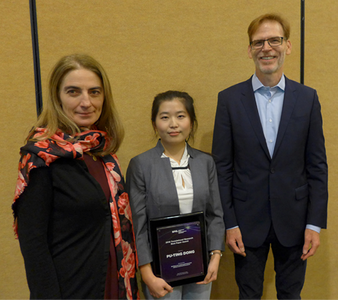Pu-Ting Dong Wins SPIE Photonics West Translational Research Best Paper Award

Research at Boston University’s Photonics Center reporting on a drug-free photonic approach to eliminating methicillin-resistant staphylococcus aureus (MRSA) earned Pu-Ting Dong (BU Chemistry Student, Dr. Ji-Xen Cheng Group) the SPIE Photonics West 2018 Translational Research Award.
Translational Research Symposium Chairs Bruce J. Tromberg of the Beckman Laser Institute and Medical Center at the University of California, Irvine (USA) and Gabriela Apiou, from the Wellman Center for Photomedicine at Massachusetts General Hospital (USA) presented the award to Dong Sunday, February 4th during a forum that focused on translational research applications of blue light.
Dong’s research found a synergy between photobleaching of staphyloxanthin (STX) with blue light and hydrogen peroxide (H2O2) in killing the highly infectious and dangerous MRSA.
“This potentially opens a new way to address a tremendous problem that the healthcare system is facing using a biophotonic technology,” Apiou said.
As Dong noted, it can take 30 years after the emergence of antibiotic resistance for a new antibiotic to be developed.
Treating MRSA is “a significant problem in infectious disease,” Tromberg, an SPIE Fellow, said, and Dong’s solution “could benefit a large number of patients worldwide.”
In a talk preceding Dong’s presentation, SPIE Fellow Michael Hamblin of the Wellman Center, explained how blue light has been found to influence circadian rhythms and magnetic fields and has become a common treatment for treating acne, low-back pain, neurological disorders, and other diseases and disorders.
Hamblin noted that a new conference at Photonics West, Photonic Diagnosis and Treatment of Infection and Inflammatory Diseases, and its 60 papers, indicated the importance of light technologies in treating a number of diseases.